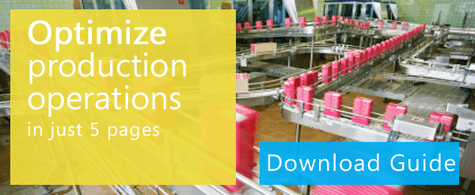Whatever the specific nature of your manufacturing operations, business success is most dependent on your people doing the very best they can at their jobs. Giving them the best tools available, enabling them to work faster, better and smarter, is key to increasing productivity and spurring company growth and profitability. Hundreds of thousands of successful organizations have found that a well-tailored enterprise resource planning system (ERP) is the exact tool needed to allow for the interconnection between each and every one of your company's critical functions, giving everyone better control over and visibility into the "big picture" of what's going on within the entire organization. This includes:
- Human resources
- Payroll
- Finance
- Design
- Supply
- Purchasing
- Sales & Service
- Production
Production Scheduling Software
For any manufacturing operation, product production and sales of those finished products is what turns the wheels of profitability, but these two functions are interdependent on a wide range of other activities to support them. The production scheduling software component of your ERP system is key to ensuring products are made and delivered on time. By being easily accessible to all departments within your organization, everybody is able to be on the same page and contributing their efforts toward reaching the same end goal.
Sustained agility and stability of the manufacturing process is fostered through clear and continued communication between those on the shop floor with personnel involved in design, procurement, inventory control, sales and customer service. When changes are made, everyone knows about it and can integrate how those changes affect their particular areas of operation. Efficient production scheduling software will also provide for:
- Meeting finite capacity constraints and notifying management of finished goods availability
- Identification of potential bottlenecks in the production flow so these can be avoided
- Providing the needed data for calculating accurate Available to Promise (ATP)
Finite Capacity Scheduling
Finite capacity scheduling concerns itself with how to most effectively deal with the particular limitations within which production must operate, such as a limited number of:
- Machines
- Machine operators
- Hours per shift
- Raw materials
The production scheduling software integrated into a quality EPR system takes these factors into account and enables production to become as streamlined and efficient as possible. Other variants it considers include the priority and status of each order on the floor, what resources are required to complete each order, when these resources will be required and/or available and what factors could cause potential delays. Data available is used to calculate the most efficient production scheduling and to avoid costly bottlenecks in the production process.
The Importance of Available to Promise (ATP)
ATP is a critical factor affecting customer satisfaction, production efficiency and business profitability. A large amount of data goes into the calculation of precise response and delivery times and ERP makes it possible to do this automatically and makes the results accessible to all concerned.
The bottom line is that when a customer makes an order, the person taking that order needs a realistic and accurate means for promising a specific delivery date. Further, to meet customer expectations and ensure a high level of customer satisfaction, that promise of delivery must be kept.
Taking into account resource capacity and materials availability, two important pieces of the complex ATP puzzle, calculations are made to achieve the desired end results of effective capacity utilization, improved delivery times and accurate delivery time quotes, fewer delayed orders and maximized profitability. High-priority customers coming in with a rush order, for example, can be accommodated and alterations to the production schedule immediately visible to all concerned. Accurate and informed decision-making is enhanced through your ability to view each new factor affecting production. 